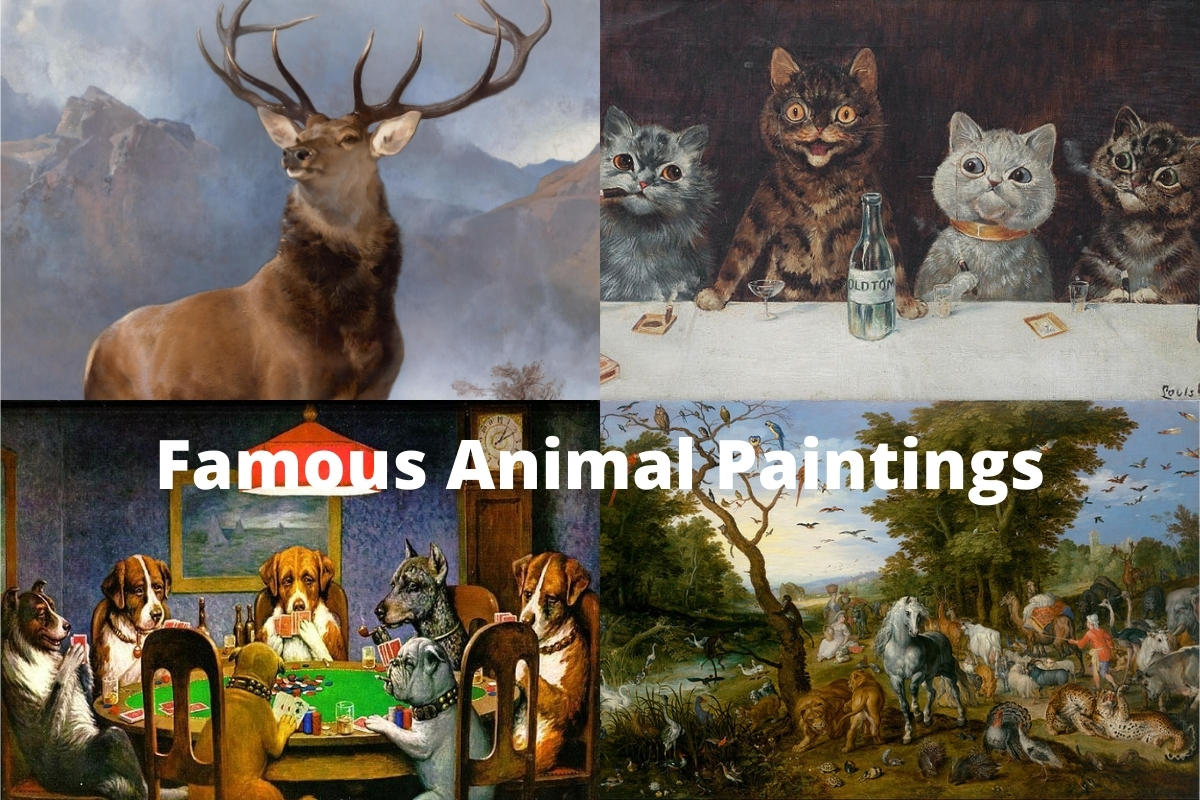The world’s diverse wildlife populations have captured the imaginations of humans for thousands of years. We are intrinsically tied to animals in order to survive and there are a number of ways that animals and humans are connected.
For many centuries, people from different parts of the world were only able to see certain species of animals in paintings.
Many prominent artists are known to have created works that featured various types of animals which were intended to symbolize certain ideas or beliefs.
In this article, we will explore some of the most famous animal paintings ever done and examine just what the artists chose to paint these particular creatures.
Famous Animal Paintings
1. The Entry of the Animals into Noahs Ark – Jan Brueghel the Elder
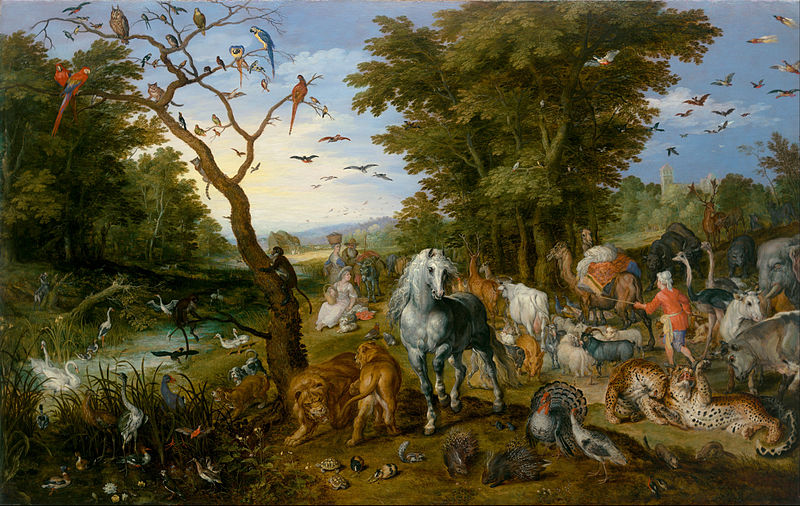
Jan Brueghel the Elder was a prominent Flemish painter who lived during the last few decades of what was still considered to be the Renaissance period.
Brueghel was known to produce works that featured various nature scenes, plants, and landscapes. He often created paintings that intermingled humans and animals in a way that highlighted their wild nature, or showcased hunting parties or humans and animals interacting.
Also Read: Lion Paintings
One of Brueghel’s most celebrated works was one that focused on the famous story from the Bible in which Noah is said to have built a giant ark and had taken two of every species of animal on Earth to save them from dying in a massive flood.
The painting is titled The Entry of the Animals into Noahs Ark and was done in 1613.
Brueghel painted Noah as he gently shepherds the various types of animals toward the massive ark where they were said to have spent 40 days floating on the surface of the water while the rest of mankind and all the world’s animals perished.
This work is one of the most well-known of any that depicts the famous Bible story and Brueghel’s unique portrayal of the animals at play with one another is much different than other works which depict the animals as marching into the ark in an orderly fashion.
2. The Monarch of the Glen – Edwin Landseer
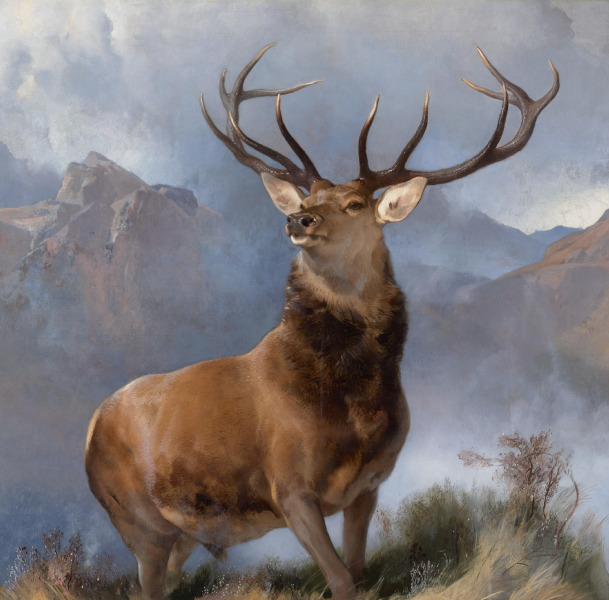
Stags and various species of antlered deer have long been used to symbolize royalty or elegance in European culture.
The red stag that is native to the hills and mountains of Scotland is one of the most impressive species of deer on the planet. Edwin Landseer painted a work that beautifully depicts this animal in its natural splendor.
Also Read: Famous Deer Paintings
This 1851 painting was titled The Monarch of the Glen as it is meant to depict the red stag as being a symbol of pride and loyalty.
Landseer was well-known for producing incredibly realistic paintings that featured nature and different types of animals and this work was widely considered to be one of his best works.
Also Read: Famous Cow Paintings
The image of the large, 12-pointed red stag has long been one of the most iconic images that was embraced by Scotland in the years following this painting.
The painting features highly-realistic details and the viewer can clearly see the wind sweeping across the stag’s hair as it stands atop the mountain ridge.
3. The Horse Fair – Rosa Bonheur
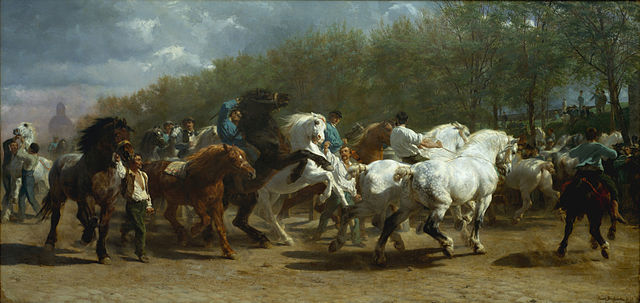
French painter Rosa Bonheur is known as one of the most famous female artists of her time and typically created works that depict animals or nature settings in great detail.
She is remembered as one of the great painters from the 19th century and her ability to capture scenes of animals in motion was unparalleled.
One of Bonheur’s most well-known works that featured animals was titled The Horse Fair. This 1852 painting features a scene of thoroughbred horses as they are paraded into the fair grounds in Paris where it was common to buy and sell horses during this time.
Bonheur’s painting drew widespread acclaim for her incredible ability to portray these horses in highly-realistic fashion. Their muscles are seen rippling under their skin and the sun is also shimmering off the well-kept coats of the horses as they run along towards their destination.
4. A Friend in Need 1903 – C M Coolidge
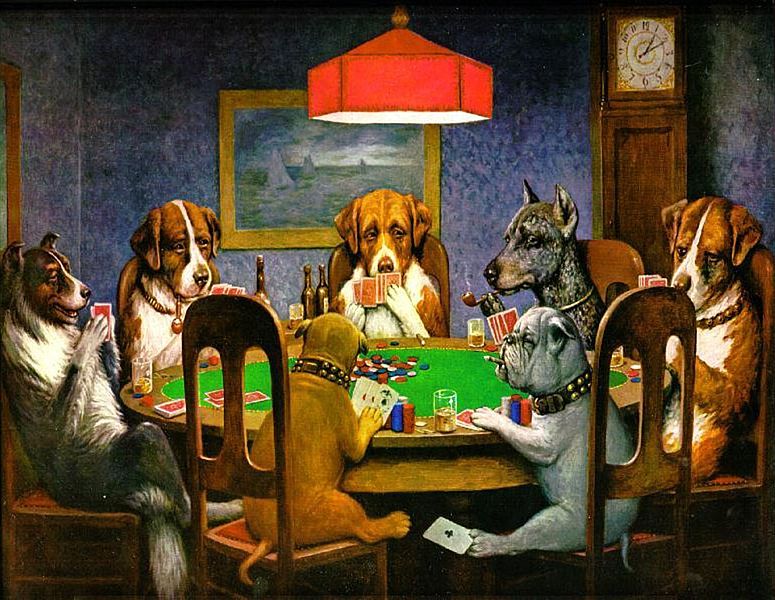
C M Coolidge was widely known for producing somewhat comical paintings of various animals engaged in different human activities.
His 1903 painting that was titled A Friend in Need is one of the most iconic works in modern times.
The painting comically depicts a group of dogs in the middle of a card game in which one of the pups seems to be soliciting help from his friend, who also happens to be the same species.
Also Read: Famous Paintings of Dogs
This painting has been recreated many times since it was first exhibited in 1903 and it is one of the most easily-recognized paintings in the United States.
5. The Goldfinch – Carel Fabritius
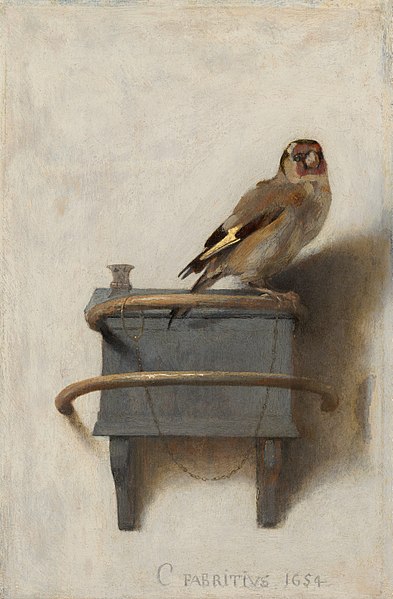
Carel Fabritius was known as one of the most prominent Dutch artists of the 17th century. He was one of the painters who was responsible for the era becoming known among art historians and critics as The Dutch Golden Age.
Fabritius regularly painted still life works that featured various animals, but most of these involved birds.
One of his most famous works is titled The Goldfinch. It was finished in 1654 and has long been praised for the artist’s subtle blending of colors to create the many different shades of golden-yellow that are what the goldfinch derives its name from.
This painting was somewhat unusual for the style of painting that made up The Dutch Golden Age.
The work was done on a wooden panel that was actually lost for more than two centuries before it once again surfaced in Brussels. It was later restored in 2003 and remains one of the most historically significant works from the era.
6. Whistlejacket – George Stubbs
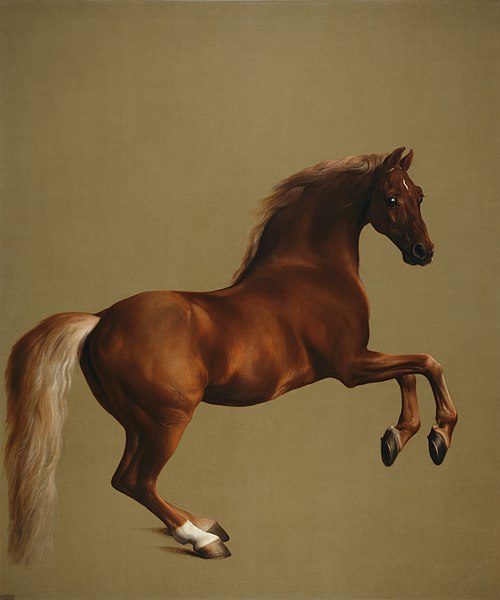
George Stubbs is remembered as one of the most well-known English painters who commonly focused on animals in his works.
Most of these paintings were centered around horses of all different breeds and a few even featured a lion stalking or attacking the horse, which is believed to have carried some sort of symbolic meaning for the artist.
Also Read: Horse Paintings
One of Stubbs’ most widely recognized works depicts a simple portrait of a horse as it rears up on his hind legs.
The painting is titled Whistlejacket and was completed in 1762. This work was hailed as one of the most strikingly beautiful works that featured a horse and many art critics noted the crisp detail of the Arabian thoroughbred.
Stubbs’ masterful use of color is on full display as he was able to give the horse a very natural-looking sorrel coloration, which seemed to be further highlighted by the solid background.
He would go on to paint many other equine works, but few gained as much notoriety as this painting.
7. The Bachelor Party – Louis Wain
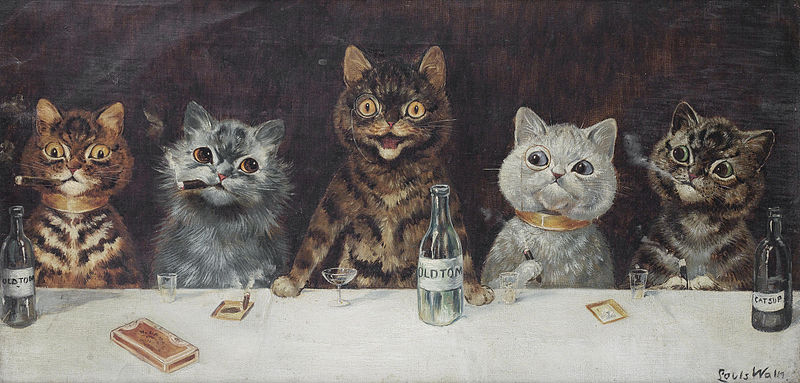
Louis Wain was a well-known English artist who seemed to have a special affinity for cats. This love for felines was made known through Wain’s many drawings and cat paintings in a variety of real and imagined settings.
Some of Wain’s most popular works included a sort of comical interpretation of cats involved in different human-like interactions.
One such work is known as The Bachelor Party. It was painted around 1939 and has since become a favorite work among cat-lovers the world over.
Wain was said to have suffered from severe mental disorders and some art historians and critics even point to some of his later works as clear signs that the artist was dealing with schizophrenia.
Despite his ongoing mental struggles, Wain’s painting known as The Bachelor Party was widely celebrated for his comical use of tom cats as they are gathered around a table enjoying drinks and smokes in the same way a group of young men often would.
The cats’ oversized, colorful eyes and their expression seem to add as much humor to the work as any other aspect.
8. Peacock, Hen and Male Pheasant in a Landscape – Tobias Stranover
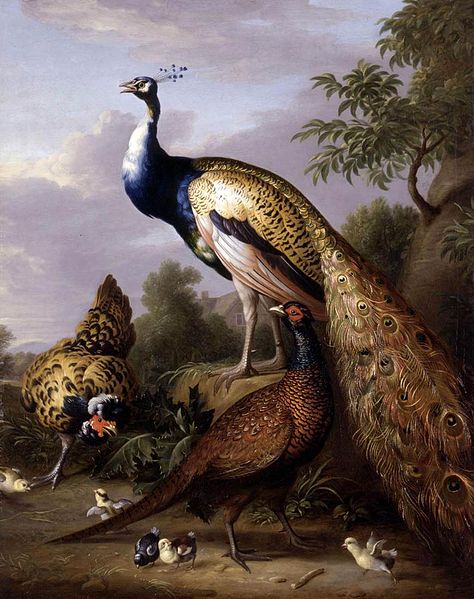
Born in present-day Romania, Tobias Stranover became a very well-traveled and accomplished artist by the time he was in his early 20’s. He was known as an artist who held special admiration for animals—especially birds of many different species.
Stranover is known to have studied under famous bird artist Melchior d’Hondecoeter, as well as others who were also fascinated with the widely-varying plumage of these creatures.
Also Read: Famous Wildlife Artists
One of his most famous works is known as Peacock, Hen and Male Pheasant in a Landscape. This painting was done some time in the first half of the 18th century.
This work was a figurative reproduction of a small animal menagerie that featured such elegant birds as peacocks and other species that were considered to be synonymous with wealth and high status.
Stranover gained considerable amounts of notoriety for his works that often featured a group of birds that were posed in ways that displayed some of their most impressive colors and plumage in the sunlight.
His painting style gave rise to a smaller movement within the Baroque period in which artists focused solely on bird paintings where they were grouped in a rather artificial way.
9. Hunting Dogs in a Boat – Winslow Homer
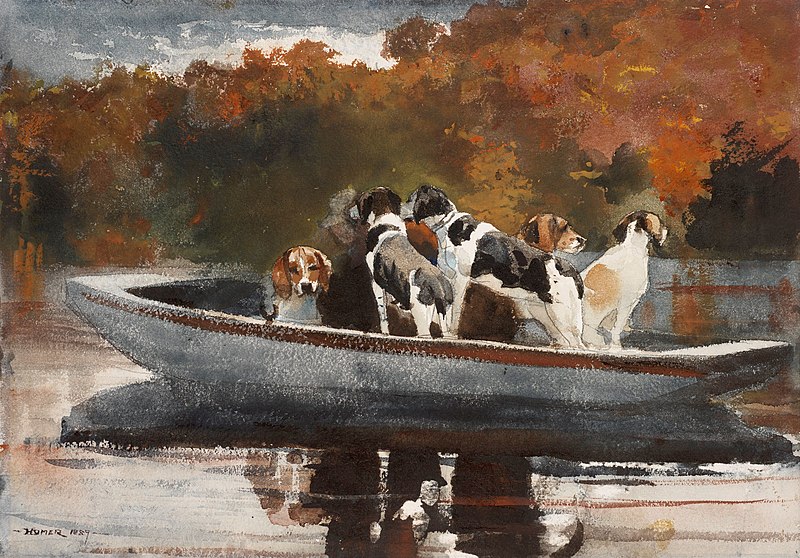
Winslow Homer was one of the most famous American artists of the 19th century. He was perhaps best known for his works that pertained to marine settings and would often create works that depicted people living, relaxing, or working along the water’s edge, or on the open sea.
One of his most celebrated works doesn’t include any people, but instead portrays a group of hunting dogs packed into a small wooden boat as it floats across a lake.
This work is simply titled Hunting Dogs in a Boat and is known to have been finished in 1889 at the height of Homer’s art career.
This painting is considered to be a masterful depiction of these hunting dogs as they are undoubtedly being brought out to an area where they would begin a hunt.
The colorful autumn leaves in the background seem to indicate that the dogs were preparing for a hunt as the fall season is commonly considered a ‘hunting’ season for many different game animal species in the United States.
10. The Floating Feather – Melchior d’Hondecoeter
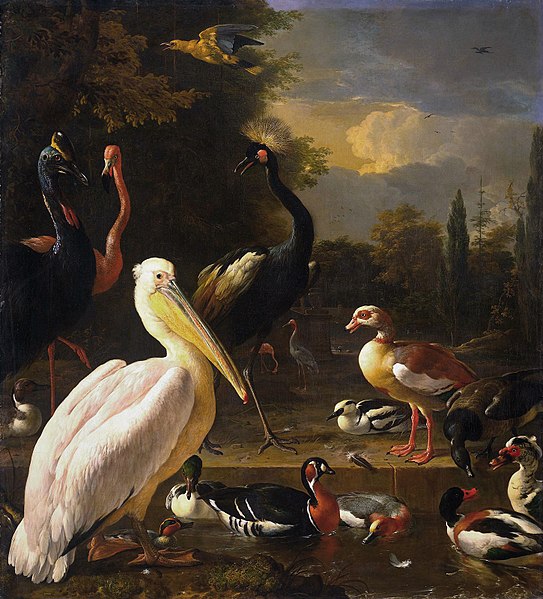
As previously mentioned, Melchior d’Hondecoeter was arguably one of the most famous artists in history that focused his efforts almost exclusively on birds of all shapes and sizes.
The Dutch painter was born in the 17th century and his career spanned until the end of the 1600’s. He was well-known for his works that featured various birds and other animals in a natural setting.
One of his most well-known works is known as The Floating Feather. This painting was another one of the famous bird menagerie works that were so popular among those with elite societal status during this time.
It was completed in 1680 and depicts a wide range of different birds that are water-dwelling species such as waterfowl, cranes, and others.
D’Hondecoeter was known to have intensely studied the plumage and anatomy of each of the birds depicted in this work and his efforts to portray them in all their natural beauty is on full display in this unique painting.
11. Yellow Cow – Franz Marc
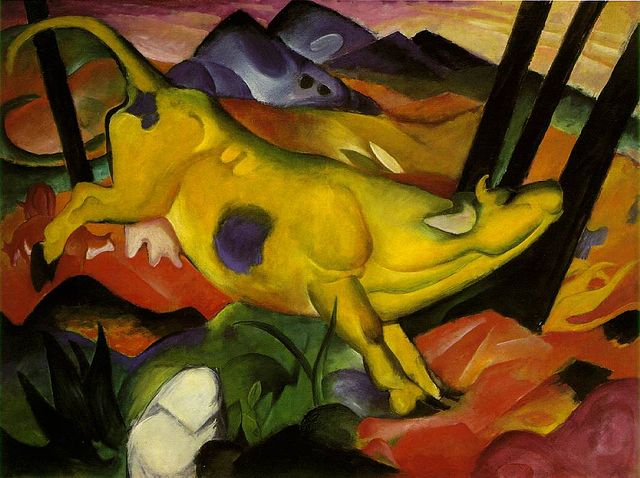
Yellow Cow is a 1911 artwork by the German artist Franz Marc.
It is one of the artist’s most well-known paintings and is one of numerous of his Expressionist-style animal portrayals. This oil on canvas painting measures 140.5 x 189.2 cm.
The painting’s principal feature is a leaping cow surrounded by a bright, organized environment. The picture is distinguished by the energetic focal subject and the serene backdrop.
The artwork is in the Solomon R. Guggenheim Foundation’s collection and has been presented in the Solomon R. Guggenheim Museum in New York.
12. Young Hare – Albrecht Dürer
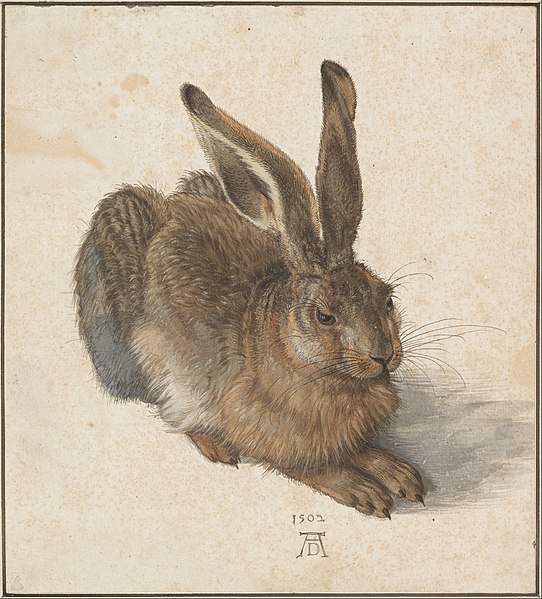
Young Hare, which is called Feldhase in German, is a painting by the German artist Albrecht Dürer that was made in 1502. It was painted in his workshop in 1502, and it and his Great Piece of Turf from the next year are both seen as great works of observational art.
The subject is drawn so well that it looks almost like a photograph. Even though the piece is usually called Young Hare, the portrait is detailed enough to show that the hare is an adult. The German title means “Field Hare,” and the work is often called the Hare or Wild Hare in English.
The subject was especially hard to draw because the hare’s fur grew in different directions and the animal had both lighter and darker spots all over. Dürer had to change the way shading is usually done to show the shape of the subject by the way light fell across the figure.
Even though it was hard to show how light looked with a multicolored and multi-textured subject, Dürer was able to create a detailed, almost scientific study of the animal.
13. The Young Bull – Paulus Potter
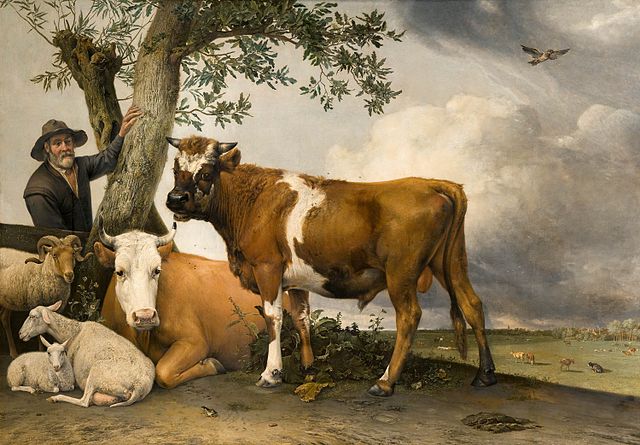
Paulus Potter depicts a young bull in oil in his artwork titled “The Young Bull.” Currently, it may be seen at the Mauritshuis, a museum in The Hague, Netherlands.
This is a life-size picture that disrupts the established genre order by depicting an animal in an almost heroic light.
This huge format allows for very realistic details, such as a swarm of insects, that were both praised and ridiculed in the 19th century.
Potter, who was born in November 1625 and passed away in 1654 at the age of 22, signed and dated the work 1647. In the 18th and 19th centuries, the artwork enjoyed widespread acclaim, although it is relatively unknown of today.

